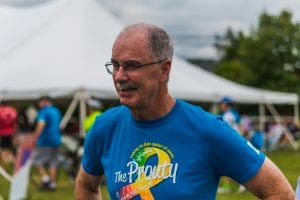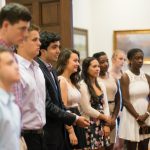As Gail and I rode the 50-mile bike route in the Prouty a couple of weekends ago, it was heart-warming to meet so many Dartmouth students, faculty, staff and alumni along the way. We joined together that day with shared purpose – to recognize and support the scientists, clinicians and patients of the Norris Cotton Cancer Center who together are leading the fight against cancer.
At Dartmouth, we hail “a profound sense of place” as a hallmark of our institution. In doing so, we often talk about the ways in which Dartmouth’s singular setting forges community and builds character. The amazing beauty of the north woods inspires and humbles, reminding us that there are much grander things in life than ourselves. The challenge of those cold February mornings and the serenity of sophomore summer are shared experiences that bind us together. At the same time, the welcoming towns of the Upper Valley, with their outstanding schools, safe environments and easy access to the outdoors, help Dartmouth attract and retain high quality faculty and staff. Indeed, the Dartmouth experience is enhanced and differentiated by our profound sense of place.
This place is defined not only by the ways in which we draw benefit from our magnificent setting, but also by the ways in which we give back. The Dartmouth campus is an artistic and intellectual hub for the Upper Valley. The same weekend of the Prouty also featured a major conference celebrating the 25thanniversary of Cornel West’s Race Matters, as well as a sold out advanced screening of Ken Burns’s documentary on country music. Dartmouth’s Division I intercollegiate athletics bring great pride to our local communities. As one of the state’s largest employers, Dartmouth contributes robustly to our local and regional economy. Together with its trusted partner Dartmouth-Hitchcock, the Geisel School of Medicine serves as a first-rate academic medical center, delivering advanced care to patients across northern New England. Beyond these highly visible contributions, the Dartmouth family has a long and distinguished history of helping those less fortunate than ourselves.
At the 25-mile mark in our Prouty ride, I met Rose and Emma – two Dartmouth students who had taken time out of their sophomore summer to support the critical work being done at the Norris Cotton Cancer Center. They exemplify the notion of service above self while appreciating the profound sense of place that defines the Dartmouth experience. I have no doubt that what they took that day from a breathtaking 50-mile ride along the Connecticut River and what they gave back to the local community through their effort will stay with them long after their time at Dartmouth is through.
I urge all of you, in the upcoming year, to join Gail and me in making a point to give back to the local community that perpetually gives so much to us. Whether it’s through projects sponsored by the Center for Social Impact, participation in events like the CHaD and the Prouty, campus-wide giving to Dartmouth’s annual United Way Campaign, or leveraging Dartmouth’s new staff policy of providing a paid day off for volunteer service, may we each do all we can to honor and support the place we call home.







